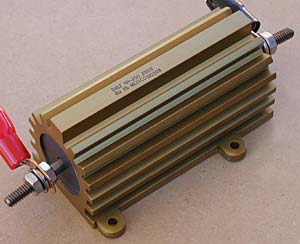A reader, Tony, suggested a couple of months ago, that I write an article on ‘The Steve Dawson method of testing Receivers’. I don’t think it’s worth an article as such, but I would like to outline my process, and why I do it.
 My technical tests are rather basic. Wire up five, six or seven, as appropriate, eight ohm resistive loads (Dale NH-250 load resistors, 250 watts capacity each, 1% tolerance) to the speaker terminals of the receiver. Plug a sine wave generator into the 5.1, 6.1 or 7.1 channel inputs (if possible, otherwise plug into stereo inputs and select 5, 6 or 7 channel ‘stereo’ mode). Put oscilliscope probes onto one of the loads, and RMS voltmeter likewise. Turn up the input signal until signal starts to clip, then turn it down a touch until the signal is perfectly clean (to the eye). Read voltmeter. Power equals V^2/8.
My technical tests are rather basic. Wire up five, six or seven, as appropriate, eight ohm resistive loads (Dale NH-250 load resistors, 250 watts capacity each, 1% tolerance) to the speaker terminals of the receiver. Plug a sine wave generator into the 5.1, 6.1 or 7.1 channel inputs (if possible, otherwise plug into stereo inputs and select 5, 6 or 7 channel ‘stereo’ mode). Put oscilliscope probes onto one of the loads, and RMS voltmeter likewise. Turn up the input signal until signal starts to clip, then turn it down a touch until the signal is perfectly clean (to the eye). Read voltmeter. Power equals V^2/8.
Do this for 100, 1,000 and 20,000 hertz. Do this for seven channels, five channels, two channels and one channel.
Clearly this isn’t a ‘real world’ test. There’s no such thing, unfortunately. The lack of reality is reflected by the following:
- loudspeakers are not resistive loads, but reactive ones — however the characteristics of their reactance varies with each speaker so there can be no widely applicable realistic test;
- receivers are never called upon to produce a continuous high level sine wave (except by people like me); and
- receivers are virtually never called upon to produce maximum power from all channels at once.
In fact, I think from a cost/benefit point of view, beefing up the power supply so that a 7 x 100 watt receiver can deliver 100 watts continuous on all channels at the same time is probably a poor design choice. A better choice would be a relatively small transformer with huge smoothing capacitors to cover peak demands.
A better test would be to choose some representative DVD sound track. Say one that works all the channels heavily. Record the pre-amp output and the speaker output and compare. Advance to volume to a point just below significant differences (ie. distortion) becoming evident. Report the average and peak output levels from all the channels. But this would involve many hours of trial and error, and still would not be truly representative (for example, since bass is higher in level than the midrange and treble, a receiver driving a sub/sat system will have an easier time of it than one driving five or seven full range speakers). I may experiment along these lines some day.
Still, I do these measurements simply because the results they deliver are a useful proxy for overall quality and performance. Just like the weight of a receiver is a useful proxy. These things say something about the care that a manufacturer has put into the receiver.
